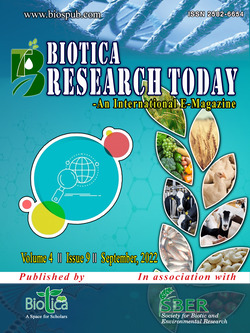
Zero Budget Natural Farming: An Agricultural Revolution
Deblina Roy
Dept. of Agronomy, Bidhan Chandra Krishi Viswavidyalaya, Mohanpur, Nadia, West Bengal (741 252), India
DOI: NIL
Keywords: Chemical-free farming, Jeevamruta, Organic farming, Zero Budget Natural Farming
Abstract
A farmer who practises zero budget natural farming (ZBNF) does not need to buy fertilizers and pesticides from the market to ensure the healthy growth of plants. It is a sustainable way to farm that aids farmers in maintaining soil fertility, restores soil health to assure chemical-free agriculture and low production costs, and thereby doubles their income. Although the method encourages chemical-free farming, there is still insufficient data to determine its efficacy. It is one of the most promising farming options or techniques in the face of unpredictable extreme weather. As it does not encourage numerous intercultural activities, as a result the engagement of hired manual labourers, it is a low cost and climate resilient farming techniques where all the inputs are locally available. This practice takes less time and effort than organic farming tasks.
Downloads
not found
Reference
Bharucha, Z.P., Mitjans, S.B., Pretty, J., 2020. Towards redesign at scale through zero budget natural farming in Andhra Pradesh. India. Int J Agric Sustain 18, 1-20.
Das, S.K., Avasthe, R.K., 2020. Organic nutrient management packages as soil policy for upgrading cropping system to restore soil productivity in Sikkim. Indian Journal of Hill Farming (Special Issue), 28-32.
Khadse, A., Rosset, P.M., 2019. Zero Budget Natural Farmingin India - from inception to institutionalization. Agroecol Sustainable Food Syst 43, 848-871.
Singh, M., Gupta, B., Das, S.K., 2018. Soil organic carbon (SOC) density under different agroforestry systems along an elevation gradient in North-Western Himalaya. Range Manage Agroforestry 39(1), 8-13.
Smith, J., Yeluripati, J., Smith, P., Nayak, D.R., 2020. Potential yield challenges to scale-up of zero budget natural farming. Nat Sustain 3, 247-252.
